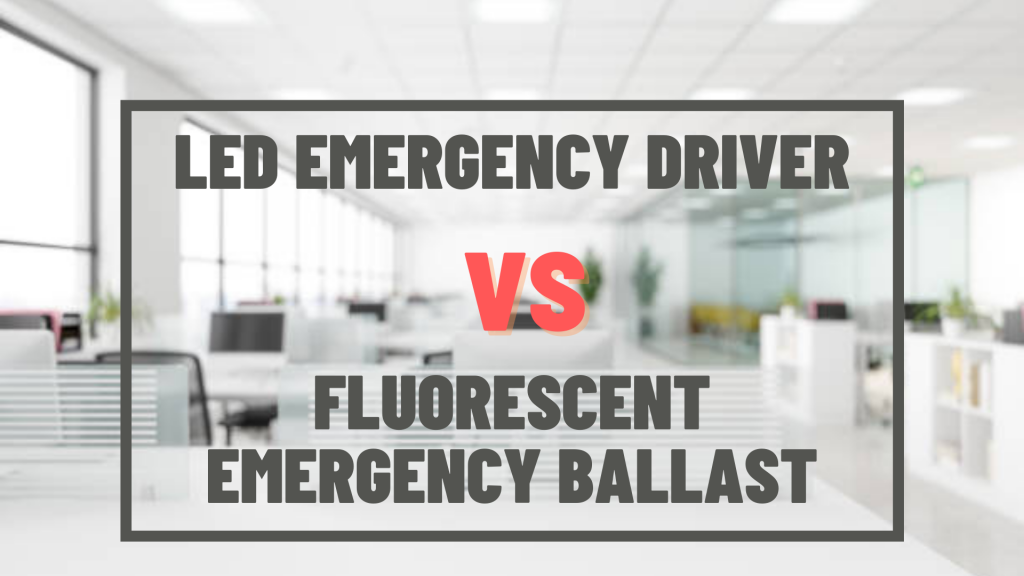Are you confused between two electrical devices: Driver and Ballast? A driver is used in LED emergency lights whereas fluorescent light uses ballast. If you are not clear about their differences, then this article will be helpful. Here, we will discuss their differences and also clarify why ballasts are not used in LEDs.

LED driver is an electrical device whose function is to regulate the power of an LED light or fixtures. It is an integral part of the LED circuit and the LED light system fails without it. An LED emergency driver is used in an LED emergency light system and this driver allows the same LED fixture to be operated in both normal and emergency mode.
In emergency mode i.e. when there is a disruption in the main power supply, the LED emergency driver switches to the emergency mode, and the LED is powered by the internal battery. The duration of time that LED light will be operated in emergency mode is about 90-120 minutes and this depends on the particular emergency driver.
Normal LED drivers operate off a line voltage whereas the emergency LED drivers are meant to operate off a battery. In emergency mode, the light output is not as bright as it would be normally. However, the light output will be sufficient for work continuity in emergency situations.
Ballast is an electrical device needed by all fluorescent and HID light systems for their proper operation. The function of a ballast is to limit the amount of current in a light circuit. If this device was not used, the amount of current could rise in the circuit and damage the lighting system.
Ballast can be considered as the functional heart of HID (High-Intensity Discharge) or fluorescent light system. Like a human heart distributes or circulates blood all over the body, a ballast manages the distribution of electrical energy throughout the light bulb or fixture and ensures that it remains lit.
Emergency light ballasts are used in an emergency fluorescent light system and they allow the light source to operate even when there is a disruption in the power supply as they operate off a battery.
Ballasts are still used in lights such as mercury vapour, metal halide and HID to avoid the rise of current. They are of two major types: Magnetic ballast and Electronic ballast.
Magnetic ballast
Magnetic ballasts (also called chokes) rely on the principles of electromagnetism i.e. when a current passes through a conductor, it produces a magnetic field around the conductor.
A copper wire is used in a magnetic ballast and the magnetic field produced when the current flows through this wire traps most of the current passing only the necessary current to a lamp. Magnetic ballasts were common in the past but are now being replaced by electric ballasts as electronic ballasts are more energy-efficient.
Electronic ballast
Electronic ballasts or electric ballasts use sophisticated electric circuits or components to control the current that passes to light bulbs or fixtures. They are lighter, smaller and more energy-efficient than magnetic ballasts.
Compared to magnetic ballasts, electronic ballasts also supply power at a much greater frequency. So, there is less chance of causing buzzing sounds or flickering with electronic ballasts. They are still used in many places where LEDs are not used.
Drivers are used in LEDs whereas ballasts are used in fluorescents and HID lamps. They are both devices that transform raw power into a form required by their respective light systems. Although their functions are quite similar, they have their differences.
Ballasts initially provide a spike of high voltage which produces an arc that passes from cathode to anode inside the discharge tube to turn the light source on. After that, their function is to regulate the current passing through the light source.
On the other hand, drivers used in LEDs act as AC to DC converter, converting AC (Alternating Current) of high voltage into DC (Direct Current) of low voltage. DC of low voltage is what is required by LEDs to operate.
There are several reasons why ballasts are not required for an LED emergency lighting system. First of all, LED lamps do not require a high amount of current.
Secondly, they generally use DC instead of an AC, so they require AC to DV converter which is in an LED driver.
Lastly, they are smaller in size compared to tube lights and other bulbs and there is no room for fitting the ballast. On the other hand, LED emergency drivers perform many functions similar to ballasts, operate more efficiently and can be designed to be much smaller.
So, that’s why LED emergency light doesn’t use a ballast but instead an emergency driver. According to some technicians, the capability of LEDs not requiring a ballast makes them produce better light and more energy-efficient.
Conclusion
We hope that this article is helpful for you to know the difference between LED drivers and fluorescent ballasts and why ballasts are not used in LED emergency lights. LED technology is currently the latest technology being used in an emergency light system. However, the choice is yours whether to go with LEDs or other light sources like fluorescents.
For all your emergency lighting solutions, remember Sanforce. Sanforce is a leading manufacturer and distributor of a diverse range of LED emergency lighting modules and fluorescent emergency kits. Also, Sanforce designs and delivers lighting products and services tailored to your specific needs.
Not sure what you required for your lightining project ?
Get in touch with us for FREE consultation.